The Nature of Contrarian Markets
During contrarian markets, strong hands sell into strength and buy into weakness. To stay on the side of strong hands, adopt a contrarian strategy when the Spread is falling. Reduce or eliminate positions in stocks which have led the market in recent months, and review laggard issues for new opportunities.
Contrarian markets are mixed markets and very often the overall trend is not supportive. For that reason alone, contrarian markets are far more difficult to trade successfully than are strength-following markets, and any trader should expect the failure rate of trades, and therefore the cost of trading, to rise.
New long positions should be taken close to support and low in the range, where strong hands are most active. Should support fail, this tactic will allow you to exit your position quickly and take a small loss.
General Electric 1987-88
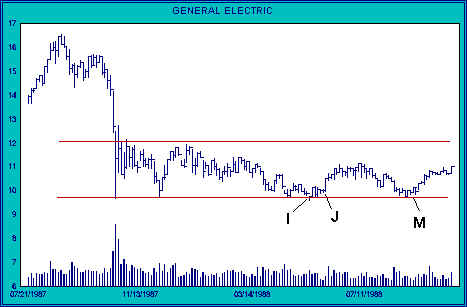
During the contrarian market of 1988 -89, GE found consistent support under 10 where strong hands were actively buying. See the discussion of GE in Chapter 2
Stocks which have passed through accumulation and which exhibit renewed strength are the most desirable candidates during contrarian markets. Because the overall trend of the market is likely to be weak, stocks which break out of a range of accumulation are likely to return for a test of support before continuing upward. Since confidence in the new trend is typically low and the temptation to take profits is high, the deepest reactions are likely to occur early on, before the uptrend has gathered momentum.
General Electric 1987-89
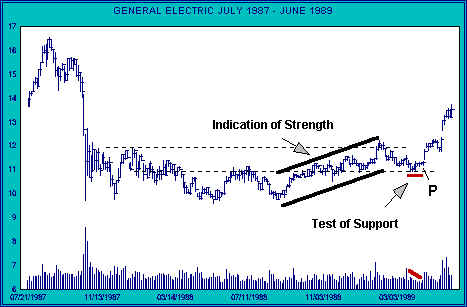
GE traverses its trading range in an indication of new strength. The test of support at P follows this indication of strength and is the last opportunity to buy GE before a powerful markup phase begins. The buying setup at P also comes near the end of the 1988 – 89 contrarian market, just before the launch of a strong strength-following market.
Because the main body of stocks tends to trade trendlessly during contrarian markets, traders place a scarcity premium on the few strongly trending groups and issues. As a result, contrarian markets may offer unusual, if very narrow, speculative opportunities.
Strong performers during contrarian markets are likely to be issues which lagged the market during the previous strength-following market phase. The Alcoholic Beverage Group is a case on point. During the two-year period from early 1992 to late 1993, this group lagged badly as the broad market advanced.
SP-500 VS Alcoholic Beverage Group 1992-93
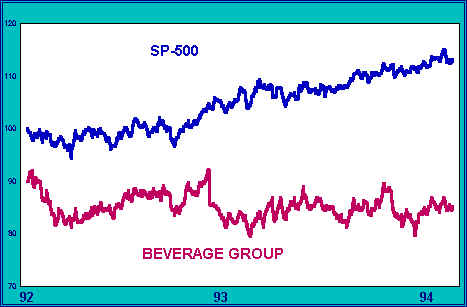
The Alcoholic Beverage Group lagged a rising market
As the contrarian market of 1994 got underway, capital began to flow into laggards.The Alcoholic Beverage Group was now viewed as a bargain, and traders began to bid up stocks within the group.
SP-500 VS Alcoholic Beverage Group 1994
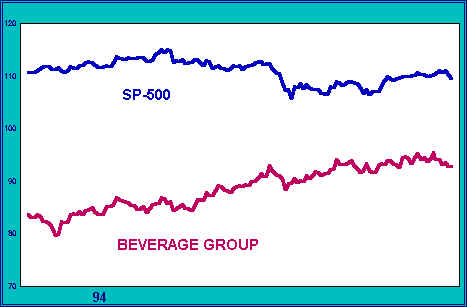
This laggard performed exceptionally well while most stocks drifted during the contrarian market of 1994
Laggards which perform well during contrarian markets often become RS leaders during the next strength-following phase. After a convincing indication of both nominal and relative strength early in the year, the beverage group dipped in a normal test of support late in 1994. This bullish setup was the last and best opportunity to buy before the group asserted its leadership during the ensuing strength-following market, which began with the new year (1995).
Alcoholic Beverage Group
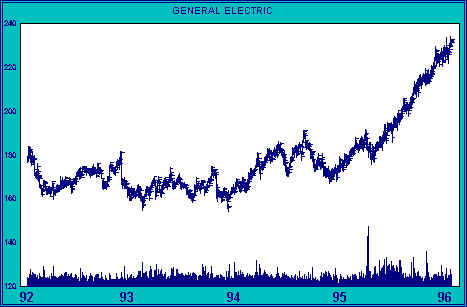
RS laggards which do well during contrarian markets often become RS leaders once strength-following returns
Two Stocks
During the strength-following market of 1992 -93, Worldcom ran with the leaders, more than doubling, while Microsoft lagged, finishing at the end of the period about where it started.
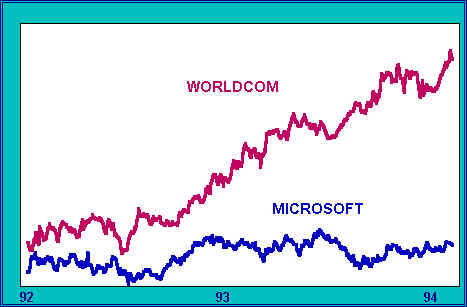
Worldcom was among the leaders, while Microsoft fell behind during this strength-following market
However, as the Spread began to fall in early 1994, the tables turned, and the Tortoise overtook the Hare.During a year in which former leaders sagged and most stocks traded irregularly, Microsoft rose by 45%.Worldcom drifted irregularly lower with the broader market.

Microsoft was among a handful of winners during the contrarian market of 1994


Join the discussion